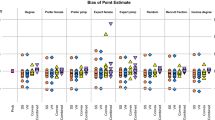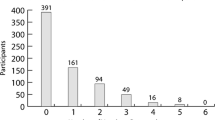Abstract
For studies using respondent driven sampling (RDS), the current practice of collecting a sample twice as large as that used in simple random sampling (SRS) (i.e. design effect of 2.00) may not be sufficient. This paper provides empirical evidence of sample-to-sample variability in design effects using data from nine studies in six countries among injecting drug users, female sex workers, men who have sex with men and male-to-female transgender (MTF) persons. We computed the design effect as the variance under RDS divided by the variance under SRS for a broad range of demographic and behavioral variables in each study. We also estimated several measures for each variable in each study that we hypothesized might be related to design effect: the number of waves needed for equilibrium, homophily, and mean network size. Design effects for all studies ranged from 1.20 to 5.90. Mean design effects among all studies ranged from 1.50 to 3.70. A particularly high design effect was found for employment status (design effect of 5.90) of MTF in Peru. This may be explained by a “bottleneck”—defined as the occurrence of a relatively small number of recruitment ties between two groups in the population. A design effect of two for RDS studies may not be sufficient. Since the mean design effect across all studies was 2.33, an effect slightly above 2.00 may be adequate; however, an effect closer to 3.00 or 4.00 might be more appropriate.


Similar content being viewed by others
References
Carlson RG, Wang J, Siegal HA, Falck RS, Guo J. An ethnographic approach to targeted sampling: problems and solutions in AIDS prevention research among injection drug and crack-cocaine users. Hum Organ. 1994;53(3):279–86.
Magnani R, Sabin K, Saidel T, Heckathorn D. Review of sampling hard-to-reach populations for HIV surveillance. AIDS. 2005;19(Suppl 2):S67–72.
Family Health International. Behavioral surveillance surveys: guidelines for repeated behavioral surveys in populations at risk of HIV. Arlington: Family Health International. 2000. http://www.fhi.org/en/HIVAIDS/pub/guide/bssguidelines.htm. Accessed 15 Nov 2012.
Goel S, Salganik MJ. Assessing respondent-driven sampling. Proc Natl Acad Sci USA. 2010;107:6743–7.
Salganik MJ. Variance estimation, design effects and sample size calculations for respondent driven sampling. J Urban Health. 2006;83(Suppl 7):98–112. doi:10.1007/s11524-006-9106-x.
Heckathorn D. Respondent driven sampling: a new approach to the study of hidden populations. Soc Probl. 1997;44(2):174–99.
Malekinejad M, Johnston LG, Kendall C, Kerr L, Rifkin M, Rutherford G. Using respondent-driven sampling methodology for HIV biological and behavioral surveillance in international settings: a systematic review. AIDS Behav. 2008;12(suppl 1):105–30.
Johnston LG, Malekinejad M, Rifkin MR, Rutherford GW, Kendall C. Implementation challenges to using respondent-driven sampling methodology for HIV biological and behavioral surveillance: field experiences in international settings. AIDS Behav. 2008;12(Suppl 1):131–41.
Heckathorn D. Respondent driven sampling II: deriving valid population estimates from Chain-referral samples of hidden populations. Soc Probl. 2002;49(1):11–34.
Wejnert C, Pham H, Krishna N, Le B, DiNenno E. Estimating design effect and calculating sample size for respondent-driven sampling studies of injection drug users in the United States. AIDS Behav. 2012;16(4):797–806.
Ruan S, Yang H, Zhu Y, et al. HIV prevalence and correlates of unprotected anal intercourse among men who have sex with men, Jinan. China. AIDS Behav. 2008;12(3):469–75.
Lane T, Raymond HF, Dladla S, et al. High HIV prevalence among men who have sex with men in Soweto, south Africa: results from the Soweto men’s study. AIDS Behav. 2011;15(3):626–34.
Johnston LG, Saumtally A, Corceal S, Mahadoo I, Oodally F. High HIV and hepatitis C prevalence amongst injecting drug users in Mauritius: findings from a population size estimation and respondent driven sampling survey. Int J Drug Policy. 2011;22(4):252–8. Epub 2011 Jun 22.
Johnston LG.: Integrated behavioral and biological surveillance survey among injecting drug users in Mauritius, 2009; Mauritius Ministry of Health, Port Louis. 2009. www.gov.mu/portal/sites/sida/idu.pdf. Accessed 15 Nov 2012.
Taran YS, Johnston LG, Pohorilac NB, Saliuk T. Correlates of HIV risk among injecting drug users in sixteen Ukrainian cities. AIDS Behav. 2011;15(1):65–74.
Heckathorn DD. Extensions of respondent-driven sampling: analyzing continuous variables and controlling for differential recruitment. Sociol Methodol. 2007;37:151–207.
Volz E, Heckathorn DD. Probability-based estimation theory for respondent-driven sampling. J Off Stat. 2008;24(Suppl 1):79–97.
Salganik MJ, Heckathorn DD. Sampling and estimation in hidden populations using respondent driven sampling. Sociol Methodol. 2004;34:193–239.
McPherson M, Smith-Lovin L, Cook JM. Birds of a feather: homophily in social networks. Ann Rev Sociol. 2011;27:415–44.
Szwarcwald CL, de Souza Júnior PR, Damacena GN, Junior AB, Kendall C. Analysis of data collected by RDS among sex workers in 10 Brazilian cities, 2009: estimation of the prevalence of HIV, variance, and design effect. J Acquir Immune Defic Syndr. 2011;57(Suppl 3):S129–35.
Johnston LG, Khanam R, Reza M, et al. The effectiveness of respondent driven sampling for recruiting males who have sex with males in Dhaka, Bangladesh: a pilot study. AIDS Behav. 2007;2(2):294–304.
Goel S, Salganik MJ. Respondent-driven sampling as Markov chain Monte Carlo. Stat Med. 2009;28:2202–29.
Poon AFY, Brouwer KC, Strathdee SA, et al. Parsing social network survey data from hidden populations using stochastic context-free grammars. PLoS ONE. 2009;4(9):e6777. doi:10.1371/journal.pone.0006777.
Gile K J. Improved inference for Respondent-Driven sampling data with application to HIV prevalence estimation. J Am Stat Assoc. 2011;106(493):135146.
Gile KJ, Handcock MS. Respondent-driven sampling: an assessment of current methodology. Sociol Methodol. 2010;40:285–327.
Acknowledgments
We would like to thank our colleagues, Shiman Ruan, Tim Lane, Jenna Rapues and Tetyana Saluk, who graciously shared their data with us.
Author information
Authors and Affiliations
Corresponding author
Rights and permissions
About this article
Cite this article
Johnston, L.G., Chen, YH., Silva-Santisteban, A. et al. An Empirical Examination of Respondent Driven Sampling Design Effects Among HIV Risk Groups from Studies Conducted Around the World. AIDS Behav 17, 2202–2210 (2013). https://doi.org/10.1007/s10461-012-0394-8
Published:
Issue Date:
DOI: https://doi.org/10.1007/s10461-012-0394-8




